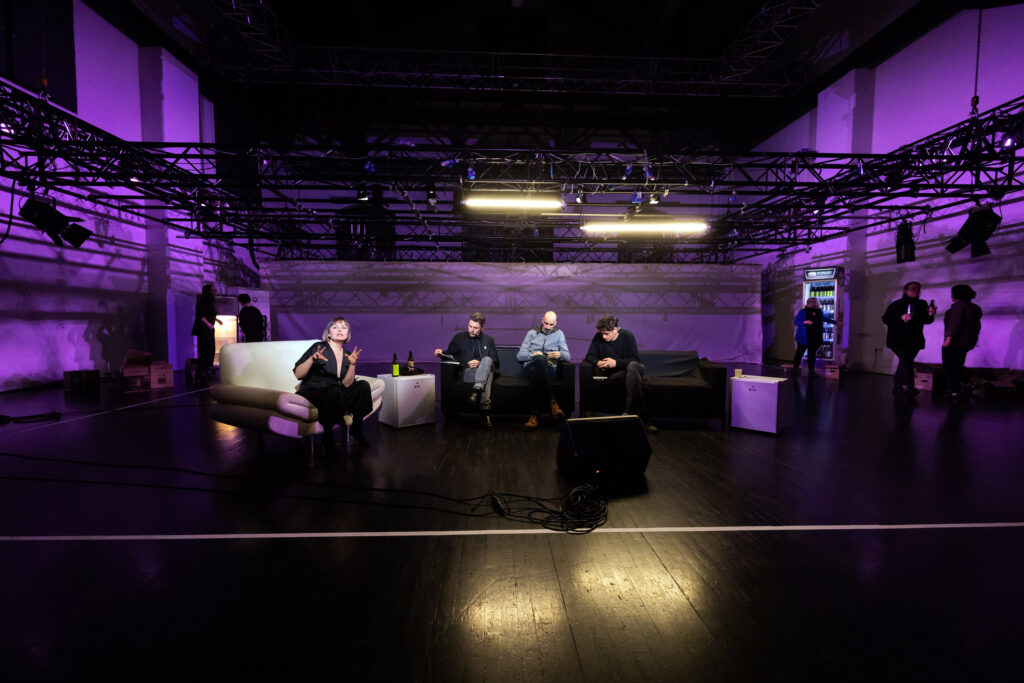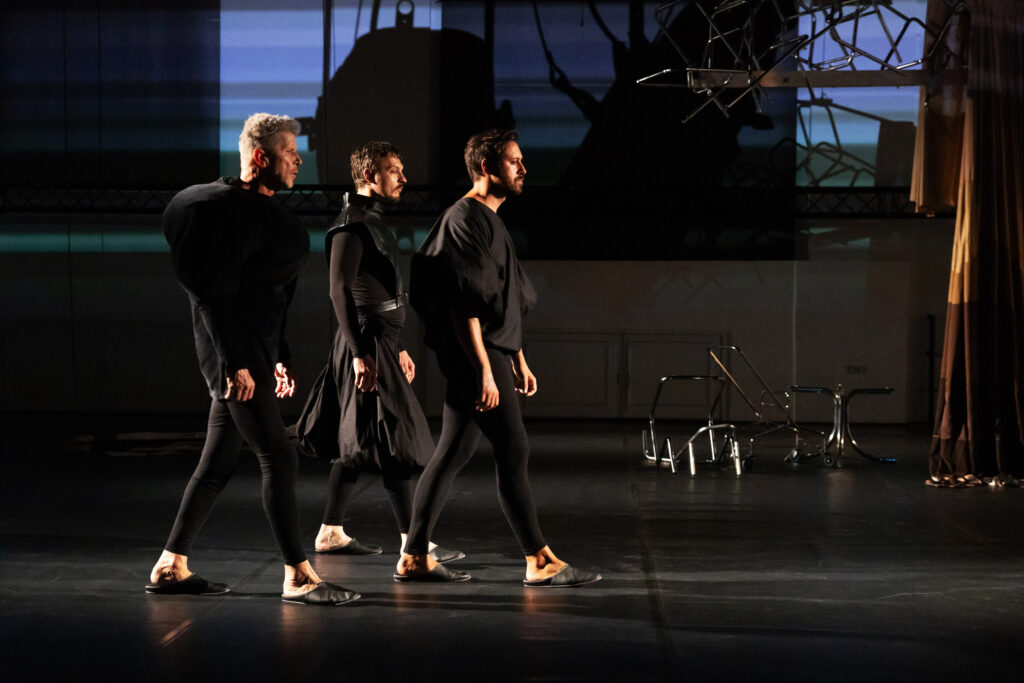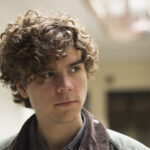Theatre maker Lea Kukovičič talks to Borisav Matić about why she staged a symposium on the oppression of men by the patriarchy and why we should stop performing Hamlet.
For much of 2023 Lea Kukovičič was trying to make men cry and, paradoxically as it may seem, save them from the patriarchy. She forced them to openly talk about their emotions (well, the few who were brave enough to submit to her will), gave them workshops on how to cry in public and directed an unorthodox version of Hamlet, the story of the first modern man. All these activities were part of the artistic-discursive trilogy When Men Cry, The World Shuts Down which consisted of a symposium, live sculpture and a theatre performance. The trilogy – produced by the NGO Bunker in Ljubljana and the theatre Prešernovo gledališče in Kranj – wrestled with questions of how patriarchy oppresses men and constipates their emotional lives. Lea Kukovičič created the trilogy together with Sodja Lotker, a dramaturg and university professor from the Czech Republic.
The interview was edited and condensed for brevity and clarity.
Borisav Matić: Feminist movements mostly observe how patriarchy oppresses women or other marginalized groups. Why did you and Sodja Lotker decide to examine how patriarchy oppresses men?
Lea Kukovičič: Every beginning of my work process is a personal investment. I choose my work from my own reality of how I relate to the world and who I am in this moment. The two-year project When Men Cry started when Sodja and I started talking about the behaviour of men around us and what is happening to them at this moment. We saw that there is some change happening.
It’s also important to mention that I’m interested in theater as an event, not as storytelling but as real social situations and how they are constructed. I’m trying to put situations in edgy formats so that we understand that they are fictions and that we can change them. The trilogy didn’t start from the feminist movement. The feminist movement, of course, is very important as a knowledge background but we are artists. Feminism has a very firm position but an artistic process is mostly about undoing the systems that we take for granted.
Nonetheless, it became clear that we are trying to tackle patriarchy as a dramatic situation. Most of the time, patriarchy and oppression are connected to women. There are tons of books written on this topic. But when we look at the patriarchy as a script, as a role-playing model, we can also see that the system is built for men but it also oppresses them. This is not part of the mainstream discourse. This oppression of men is still taboo in our society. Through research, we realized that men die much earlier and with more violent deaths than women. Our research took an artistic form that not only aimed to create specific knowledge or proposal, but also create spaces of discussions and activate some possibility of re-consideration of this taboo. And then, of course, we came up with the proposition to save men from patriarchy.
BM: Why has men’s oppression in patriarchy remained a taboo? There was at least a sporadic men’s liberation movement that was not cynical nor anti-feminist. Feminism itself helped a lot of men to get out of the repressive gender roles. On the other hand, not a lot of art deals with this topic.
LK: I’m not exactly sure. I think it has a lot to do with generations and family. We pretend that we live in this world of equality and emancipation, but it’s obviously not like that. In The Will to Change bell hooks writes about family as the first oppressive tool. But then she also mentioned that even though it’s possible for men to get rid of patriarchal patterns within a family, when they go out to society it basically hits them back. We live several different patriarchal realities and it’s a complex situation, full of fictions and rituals we follow. That’s why in some parts, it’s still a taboo.
Another part has to do with generations because patriarchy works with waiting for power. When you’re younger, you’re promised you will get power when you get older. Younger generations have different problems with patriarchy than older ones. Even though the oldest generation, of our parents for example, can see or feel that there are some problems with the patriarchy but they don’t really know how to act on it. They cannot do anything differently than repeat the older patterns. Then the question is also when someone younger comes to the point when power belongs to them, what to do? Power is a shortcut to success which is nowadays the ultimate social aim.
Here we come to the question of how to change the situation, how to help those who are oppressed. At the symposium, we had a very specific situation because all the men who were speakers at the symposium were straight white men.
BM: Can we interpret that these straight white men are unable to speak about their emotions because they are crippled by patriarchy, and the only way to help them is for women to moderate discussions on these topics with them?
LK: The final decision for the symposium to invite only straight, white, cisgender men who are also more or less the same generation, all over 40, all successful theatre makers, aimed to focalize the symposium by placing together people who have a similar context. We knew from the beginning that we wanted to reverse the roles. Usually, men have the power but here we wanted to put men in a situation where we want to help them. Helping is the ultimate patriarchal tool, so we used it in order to uncover it. We wanted to show those invited men how they are oppressed and how they oppress women. Therefore the symposium was designed as a performative situation. All the physical labour was done by a group full of women.

Simpozij o čustvenosti moških v patriarhatu. Photo: Nada Žgank.
BM: Full of women or all women?
LK: The symposium was organized, moderated, facilitated, served and directed by women. I say full of women because at the event there were 3 male technicians who were not allowed to enter the stage. We wanted to create this clear division and border – men speaking, women serving and fixing things. The symposium started with a lecture by Federico Campagna on the mythological aspect of patriarchy. Then there was a discussion by invited speakers moderated by Eva Neklyaeva. While men were talking, the audience and speakers were being served by women – the whole Bunker production team, Sodja, friends, volunteers, and I took care of them. The symposium was rounded up by the speech of the director of the Institute for the Study of Gender Equality Ana Pavlič. And it ended with a male choir performing sad pop songs.
BM: Let’s dig a little bit deeper into why you decided to invite only straight white men and not, for example, trans-, bi or gay men. Why was this monolithic structure in terms of identity important to you?
LK: We created the symposium with the thought that this is the first of the series. So we began where we think most “help” is needed. And as we are a small crew, we need to prioritize so we made a list of sexy men we wanted to save. But it quickly became very difficult. We confirmed that there is something very serious about the situation because most of the people invited didn’t want to participate. That was the point of seeing that we were on to something. Hopefully, in the future, we will have the possibility to create a queer edition, because queer communities have a lot of knowledge on transitions and breaking out of the cages and re-entering new ones.
BM: How many men declined to participate in the symposium and how many participated in the end? What were the reasons for declining to participate?
LK: We had a very hard time finding three men at the end. I think the ratio was around 23 men who were approached and three of them said yes. Some of them didn’t want to talk or didn’t think they had things to say about the topic. Some of them were too busy. It also had to do a lot with being in a quite uncomfortable position, as they perceived it as a submissive position.
BM: Who were these three brave men who participated in the symposium? What were the highlights of the event?
LK: There was Julian Hetzel, a theatermaker and visual artist currently based in Amsterdam but born in Black Forest. He also works with social structures and realities, trying to realize what is behind them. Then there was Primož Bezjak. He is based in Ljubljana and works as an actor in institutional theater, but also works on the independent scene with his own theater group and on other projects. And Juan Carlos Martel Bayod, a Spanish theater director who is currently working as an artistic director of Fondazione Teatro Lliure, an institutional theater in Barcelona. They’re all men from the theater background but we tried not to talk about their work. We tried to see if it’s possible to systematize their personal stories, to think about how the systems are created from personal stories.
One of the interesting parts of the symposium was that the speakers were the focal point but at the same time, not really. The audience was the one being served. There were no breaks. People went out to smoke and came back. They missed parts. It was super interesting – at some point what the speakers talked about became like a white noise to the audience. People also discussed with their colleagues, with people they came with… It was intended to be chaotic because one of the points was to create spaces of thinking. We were trying to provoke thoughts not just serve knowledge. There was this unbelievable mixture between not listening and deep listening. There were moments of vacuum, nervousness, a lot of slow take-offs for the topics, heaviness. So It was a serious situation but at the same time, it had a lot of humour in it. The whole event was titled When Men Cry, The World Shuts Down. But unfortunately, there was nobody crying.
BM: A pity.
LK: And for the full disclosure, we didn’t save men from the patriarchy. But we tried, half a man at a time.
BM: The second part of the trilogy When Men Cry is an artistic intervention or live sculpture, as you call it, The Last Hamlet, Foreplay which was performed during the week of Slovenian drama at the theatre Prešernovo gledališče in Kranj. What is the concept of a live sculpture and who is the last Hamlet?
LK: The live sculpture is basically a sculpture of men performing crying in public space. It’s an expression of a human body that behaves like a sculpture. This sculpture can be performed anywhere but it was performed as a try-out at Prešernovo gledališče in Kranj because the theatre was a co-producer of the trilogy. There were four images depicting different constellations of men crying. The sculpture was developed in two days through a workshop with men whom I taught how to cry. This is not a therapy session but a very technical coaching session on how to cry in public. The workshop allowed men to get used to crying in front of each other. Later, when the event was happening, they were crying in front of familiar and non-familiar faces. These images of men crying exposed the audience to what they’re not necessarily used to. The simplicity of the images allowed the audience to project their own memories and ideas onto them. This artwork has now a life of its own and it is being performed under the title The World Shuts Down. But to answer the question of who is the last Hamlet in this part, it is the thought.

Zadnji Hamlet. Photo: Nada Žgank.
BM: You also directed the last part of the trilogy, the theatre performance The Last Hamlet which premiered in September. There you had the chance to explore the topics of the trilogy in a more classical theatrical form. In Shakespeare’s Hamlet, the character is between the need to express his emotions and project the image of tough, traditional masculinity. The play is also widely interpreted in different ways from the perspective of gender studies. How did you approach Hamlet?
LK: Hamlet is believed to be the first modern man. We also felt that if we take Hamlet, we could question it as a leading text of Western theatre. Through that, we could start more efficiently asking questions about power, family and the canon. We took a closer look from the perspective of theatre makers, as there is this institutional belief of greatness, bowing to the man who wants to be a king and wants power – these are super-questionable values that are presented in the text.
Hamlet is also the most performed play in Slovenia throughout history, 33 times. We also calculated that it is possible that Hamlet is being performed every hour in the world. It’s like a social obsession. But also, one important aspect is that family is very important, what we were already talking about before. Hamlet could also be thought of as a Sunday lunch. There is an amazing book written by Jelisaveta Blagojević called Politike nemislivog: Uvod u ne-fašistički život (Politics of Unthinkable: An Introduction to Non-Fascist Life). She started off the prologue by writing about the Sunday lunch as something that’s always the same. It’s every Sunday, you don’t want to go, but you go. All the people that you know and all the ghosts are there. The dog is in the corner. Grandmother, she’s also sitting in a wheelchair. The grandfather is already dead and his picture is hanging on the wall. The father already took the central position at the table. He’s kind of directing us. The daughter is vegan and a fighter for people’s rights. There are many options for the son. The son could be too feminine or he already has the three things he needs, a car, a wife and a house. So she’s talking about this Sunday lunch as a focal part of what happens in the family and in society. Metaphorically, the situation of the Sunday lunch is everywhere, in churches, bureaucracy, schools. Everything starts with family, including patriarchy. Family is also very important in Hamlet. It starts with the death of the father. We approached it in a way that we did not tell his story but questioned social situations and rituals connected to it.
BM: You also mentioned that Hamlet’s values are not the values of today and that is something that you address in this performance. What do you mean by that?
LK: We were fed up with this ethical part. He thinks he’s very just and ethical because he studied, knows philosophy, but in relation to others, he fails completely because it’s something connected with this constant lack of overview. But at the same time, he is fighting for an overview. It’s like he wants to be a God, but he doesn’t have the view. His idea of justice gets people killed. What are Hamlet’s values – the human is the center of attention. All those needs for constant fights – who is the king, all the needs for killings, all the needs for constant repetition of sameness. The Last Hamlet is a reconsideration of how to do things differently. That’s the important part, that we should stop doing this. Not just making new productions of Hamlet, but the oppressions of others and ourselves.
BM: You’re a co-selector of Bunker’s festival Mladi levi (Young Lions) which last edition occurred in August 2023. The festival has a diverse program but mainly presents independent artistic projects that range from musical theatre to dance to classical drama theatre. How do you see the role of this festival on the Slovenian and regional cultural scene?
LK: The Mladi levi festival has been present in the Slovenian and regional scene for over 26th years. It was established by Nevenka Koprivšek as a counterpart to the big festivals such as Festival d’Avignon to present younger and not-known artists. Therefore it has been very important in the Slovenian and regional scene because it always presents among other artists from Slovenia and the region. Through the years Mladi levi became a performance art festival that brings exciting artists, known and unknown, from all around the world to Slovenia. Its mission has always been that it is accessible to all, therefore it is a free festival – and it keeps this policy even though it is organized with less and less money every year, as most of the smaller festivals are. The ticket costs a symbolic 1 euro. Festival allows the collective exercise in imagination of what is possible –aesthetically but most importantly in living, thinking and co-existing.
BM: You decided to devote special attention to the idea of community and participatory art at last year’s festival. Why did you decide on this concept?
LK: I am part of the collective of women that organize the Mladi levi festival, I co-create the program with 2 co-programmers: Mojca Jug – who has been with the festival since the beginning –and Klara Drnovšek Solina. But it’s important to understand that the whole festival is not created solely by the programming team but by the whole collective of Bunker. The urgency of the topics of community and participatory art is not new, yet is crucial to underline how festivals and theatre meet life and how life meets festivals and theatre. Historically festivals have always created community, festivals are celebrations, a utopia to be able to survive another year … and in this sense, festivals are also always participatory. And right now the question is what is the future of the festival?
For more information, visit: bunker.si
Borisav Matić is a critic and dramaturg from Serbia. He is the Regional Managing Editor at The Theatre Times. He regularly writes about theatre for a range of publications and media.
He’s a member of the feminist collective Rebel Readers with whom he co-edits Bookvica, their platform for literary criticism, and produces literary shows and podcasts. He occasionally works as a dramaturg or a scriptwriter for theatre, TV, radio and other media. He's the administrator of IDEA - the International Drama/Theatre and Education Association.








